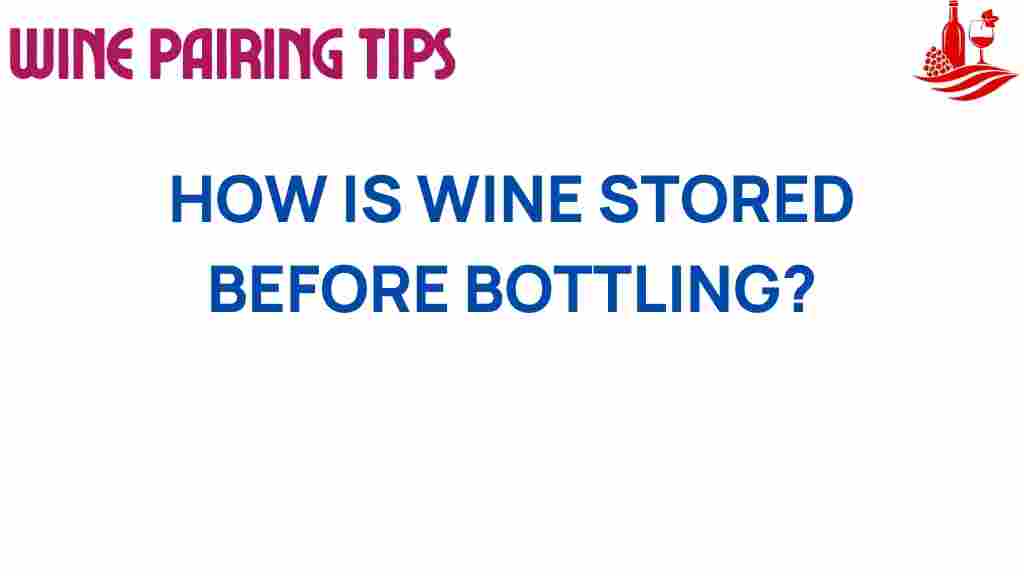Unveiling the Secrets: How Wine is Stored Before Bottling
When it comes to winemaking, the journey from grape to glass is filled with intricate processes, each contributing to the character and quality of the final product. One of the crucial stages in this process is wine storage before bottling. Understanding how wine is stored, the bottling process, and the various techniques involved in fermentation and aging can significantly impact the quality of the wine. In this article, we’ll explore the secrets behind wine storage, the importance of cellar conditions, and how these factors contribute to wine preservation.
Understanding the Winemaking Process
The journey of winemaking begins in the vineyard, where grapes are harvested at the peak of ripeness. This is followed by several key processes:
- Harvesting: Picking grapes at the right time is crucial for achieving the desired flavor profile.
- Crushing and Pressing: Grapes are crushed to extract the juice, which is then pressed to separate the liquid from the skins.
- Fermentation: Yeast is added to the juice to convert sugars into alcohol, producing wine.
- Storage: After fermentation, wine is stored in various containers, such as oak barrels or stainless steel tanks, to develop its flavors.
- Aging: Wine is aged for a specific period to enhance its complexity and taste.
- Bottling: Finally, the wine is bottled and labeled, ready for sale.
The Importance of Wine Storage
Proper wine storage is vital for preserving the quality of the wine before it reaches the consumer. It involves creating optimal cellar conditions that ensure the wine remains stable and flavorful. Here are some of the critical aspects of wine storage:
1. Temperature Control
Temperature plays a significant role in how wine develops. The ideal storage temperature for wine is typically between 45°F and 65°F (7°C to 18°C). Fluctuations in temperature can cause wine to age prematurely or lead to undesirable flavors.
2. Humidity Levels
Humidity should be maintained between 50% and 70%. Too much humidity can promote mold growth, while too little can dry out corks, leading to oxidation. This balance is essential for wine preservation.
3. Light Exposure
Wine should be stored in a dark environment. UV light can degrade wine quality, altering its flavor and aroma profiles. Using dark bottles can help mitigate light exposure, but it’s best to keep wine in a dark space.
4. Vibration
Vibration can disturb the sediment in wine and affect its aging process. Wine should be stored in a stable environment, free from heavy machinery or frequent movement.
5. Orientation of Bottles
Storing wine bottles horizontally keeps the cork moist, preventing it from drying out and allowing air to seep in. This can help maintain the wine’s integrity over time.
The Bottling Process: A Critical Step in Winemaking
Once the wine has been properly aged and is ready for consumption, the bottling process begins. This stage is crucial for ensuring that the wine retains its quality and flavor. Here’s how the bottling process typically works:
1. Quality Control
Before bottling, extensive quality control checks are performed. This includes:
- Tasting samples from different batches to ensure consistency.
- Checking the chemical composition to meet industry standards.
- Analyzing for any faults or off-flavors that could affect the final product.
2. Filtering
Many winemakers choose to filter the wine before bottling. This process removes any remaining solids and helps clarify the wine. It can also help prevent spoilage.
3. Filling Bottles
Once the wine is ready, it is bottled using automated or manual filling machines. Care is taken to minimize exposure to oxygen during this step to preserve the wine’s quality.
4. Corking
After the bottles are filled, they are sealed with corks or screw caps. Proper sealing is essential to prevent oxidation and maintain the wine’s flavor.
5. Labeling and Packaging
Once sealed, bottles are labeled and packaged for distribution. This step also includes ensuring that all legal and regulatory requirements are met.
Common Challenges in Wine Storage and Bottling
Proper wine storage and bottling practices are essential, but challenges can arise. Here are some common issues and troubleshooting tips:
1. Oxidation
If wine is exposed to excessive oxygen during storage or bottling, it can lead to oxidation, resulting in off-flavors. To prevent this:
- Minimize air exposure during bottling.
- Use inert gases like nitrogen during the bottling process.
2. Temperature Fluctuations
Sudden changes in temperature can harm wine quality. To combat this:
- Invest in a temperature-controlled wine cellar.
- Monitor temperature regularly to avoid fluctuations.
3. Cork Taint
Cork taint is caused by a compound called TCA, which can lead to musty flavors in wine. To avoid this:
- Source high-quality corks from reputable suppliers.
- Consider alternative closures like screw caps.
4. Sediment Issues
Older wines may develop sediment, which can affect clarity and taste. To manage this:
- Allow wine to settle before bottling.
- Use a decanter when serving to separate sediment from the wine.
Conclusion
Understanding wine storage before bottling is crucial for any winemaker looking to produce high-quality wine. By maintaining optimal cellar conditions, controlling temperature and humidity, and following a meticulous bottling process, winemakers can ensure that their wines are preserved perfectly.
The journey from the vineyard to the bottle is a complex one, requiring attention to detail and a deep understanding of the winemaking process. By embracing best practices in fermentation, aging in oak barrels, and quality control, winemakers can create exceptional wines that delight consumers worldwide.
For more information on wine preservation techniques, visit this resource. If you’re interested in learning about the various types of wine and their unique qualities, check out this guide.
This article is in the category Tips and created by Wine Pairing Tips Team
